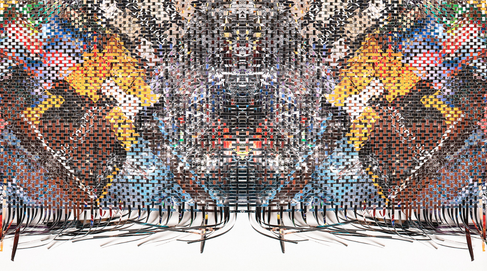The Fluidity of Borders and the Warmth of Paper: The Artistic Journey of Carmel Ilan
Born in 1960 in Jerusalem, Israel, Carmel Ilan’s journey into the art world began in the diverse and historically rich neighborhood of Abu Tor. The experience of living near the wall separating Jewish and Muslim parts of the city during her childhood, and witnessing its removal after the Six-Day War, deeply influenced her perspective on borders and change. This concept of fluidity is central to Ilan's work.
Growing up in an environment where art was highly appreciated, with a mother who owned a gallery focused on Jewish art, Ilan was exposed to the art world early on. Weekly visits to galleries and museums nurtured her fascination with art. This background led her to study fashion design at Shenkar College in Tel Aviv and Parsons School of Design in New York, grounding her in historical research, development, and experimentation.
After a successful career in fashion design and creating a children’s furniture brand, Ilan’s artistic journey took a transformative turn. The birth of her third child and a desire to return to her creative roots led her to study sculpture at Basis Art School. It was here that Ilan discovered her affinity for used paper, finding it an expressive and versatile medium.
Ilan’s work, which bridges the realms of painting and sculpture, is characterized by its unique use of paper. She collects discarded books and meticulously folds and weaves their pages into intricate, layered artworks. This process is not only a form of recycling but also an intimate, meditative practice that connects Ilan to ancient crafts like sewing and knitting.
Her innovative approach has led to exhibitions at renowned venues such as the Plaza Gallery in Tokyo, ZK Gallery in San Francisco, and the Performing Arts Centre in Tel Aviv. Ilan’s work has also been featured in major international fairs including Art Basel Miami, Art Central Hong Kong, and Art Toronto.
In Ilan’s words, she hopes that her work evokes an emotional response, allowing viewers to feel the warmth and depth of her creations. While she acknowledges that her work builds on the foundation of art history, her unique path has allowed her to develop a distinctive artistic language.
Ilan’s ongoing exploration of paper’s potential, combined with her unique folding techniques and innovative use of scanning technology, continues to push the boundaries of contemporary art. Her work not only reflects her personal journey but also resonates with a broader audience, bridging the old with the new and inviting viewers to engage with art in a deeply personal way.












Comments